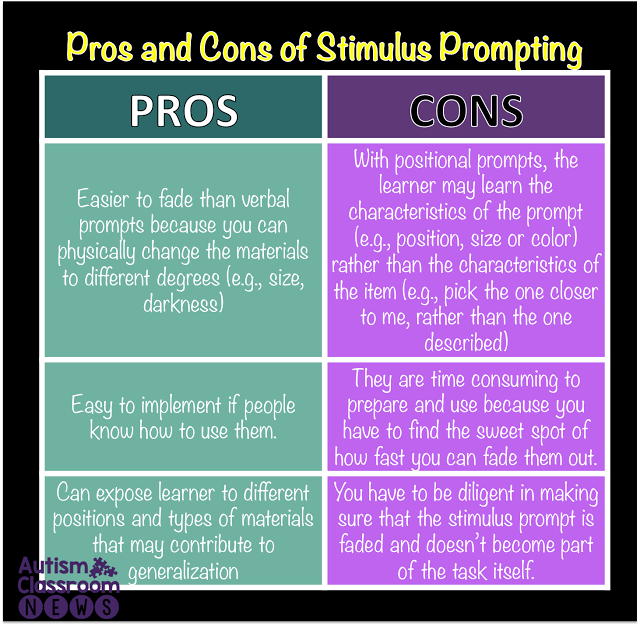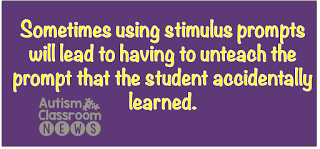Sharing is caring!
 In the last post I talked about what stimulus prompts are and gave you some examples. Today I want to talk about some of the pros and cons of using stimulus prompts. Some of you may be new to stimulus prompts, some may have been using them without realizing it, and some of us have been using them for a long time but there are some considerations in the literature that are worth thinking about when planning out your prompting. Remembering that we have two primary goals in instruction: correct answers and independence. We don’t want the student to learn the wrong thing so we want to make sure we highlight the right elements so they can continue to learn. Discrete trials are a pretty intensive type of instruction, even when you embed them in instruction or do them in groups (yes you can do them in groups and I’ll talk about that later in the series). We use them because the students don’t learn well from instruction given to a whole class and because they need very precise control over the materials themselves, presentation of materials, and consequences to their behaviors. Clearly our goal has to be to fade out prompting, but we want to make sure that when we fade them, we don’t lose the student because he focused on the prompt instead of the color or animal or whatever we are trying to teach about.
In the last post I talked about what stimulus prompts are and gave you some examples. Today I want to talk about some of the pros and cons of using stimulus prompts. Some of you may be new to stimulus prompts, some may have been using them without realizing it, and some of us have been using them for a long time but there are some considerations in the literature that are worth thinking about when planning out your prompting. Remembering that we have two primary goals in instruction: correct answers and independence. We don’t want the student to learn the wrong thing so we want to make sure we highlight the right elements so they can continue to learn. Discrete trials are a pretty intensive type of instruction, even when you embed them in instruction or do them in groups (yes you can do them in groups and I’ll talk about that later in the series). We use them because the students don’t learn well from instruction given to a whole class and because they need very precise control over the materials themselves, presentation of materials, and consequences to their behaviors. Clearly our goal has to be to fade out prompting, but we want to make sure that when we fade them, we don’t lose the student because he focused on the prompt instead of the color or animal or whatever we are trying to teach about.Some of these are pretty self-explanatory so I will let the graphic speak for itself to some degree and just hit the highlights. One of the greatest plusses to stimulus prompts is that you can fade them in small increments down to a minimum that you can’t really reach with a verbal prompt for example. For instance, I can make the communication visuals closer and closer to the same size in the picture below until they are an identical size. If I was using verbal prompts I can only make what I am saying so much shorter or softer.
However, one of the biggest concerns about the use of stimulus prompting is that often the prompt becomes what the student learns rather than the relevant elements. So in the picture above, he might learn, the big one is the one I use to get what I want (the popcorn) instead of the one with yellow kernels indicates popcorn. Many experts would say when teaching receptive language and vocabulary, you should avoid positional prompts and/or stimulus prompts in general for this reason. The argument behind it is that you don’t want to highlight the WRONG element (e.g., position, size). Now clearly in ABA and any good instruction, there is no one size fits all solution. Some students will do well with these types of prompts and others will focus on the wrong thing. If you aren’t sure, I would suggest avoiding using stimulus prompts when teaching vocabulary in particular because if they do focus on the wrong thing and incorporate the prompt into their learning, you are going to have to spend time unteaching the mistake and reteaching the right thing.
 We had what I like to call a “Training Failure.” Those of us who trained the teachers took it for granted that the teachers would eventually use sentence strips and visuals that were not color-coded. Yet, we didn’t make them or give them any. We didn’t demonstrate for them how to do that. I’m not even sure (I can’t believe I’m admitting this) we told them to do this. So guess what ….they never faded the stimulus prompts (or rather most of them didn’t). Consequently, what the students learned was not to be able to find a visual that said, “I want” but to find the visual with the “red” border. If we had put a red border around a picture of a dog, I’m pretty sure some of the students would have asked for something with a sentence that said: “Dog pizza” instead of “I want pizza.”
We had what I like to call a “Training Failure.” Those of us who trained the teachers took it for granted that the teachers would eventually use sentence strips and visuals that were not color-coded. Yet, we didn’t make them or give them any. We didn’t demonstrate for them how to do that. I’m not even sure (I can’t believe I’m admitting this) we told them to do this. So guess what ….they never faded the stimulus prompts (or rather most of them didn’t). Consequently, what the students learned was not to be able to find a visual that said, “I want” but to find the visual with the “red” border. If we had put a red border around a picture of a dog, I’m pretty sure some of the students would have asked for something with a sentence that said: “Dog pizza” instead of “I want pizza.”
So, stimulus prompts can be useful but we really need to think about how they might affect our teaching. Our students don’t have time to learn something and then unlearn it and relearn it–nor do their teachers. Smart use of prompts can make instruction more efficient. Next we’ll talk about how to fade response prompts.
Also, at the request of many folks on Facebook, I am working on making a printable of the infographic from the first prompting post that you can check out here.
And on Sunday, May 17 at 8 PM I am participating in the School Psyched Podcast. You can participate through their Facebook Page and YouTube as we do a Google Hangout. This is a new thing for me but I have lots of interesting ideas I will be exploring over the summer like this so I’m excited to get the opportunity to participate with this great group of psychologists to share information about autism!
Until next time,










